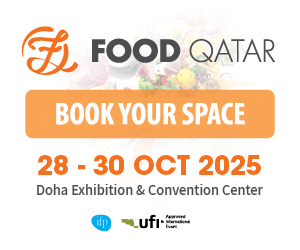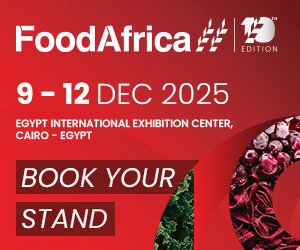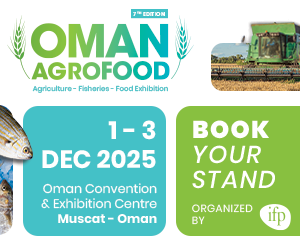The processed meat market in Africa is anticipated to continue its growth trajectory due to rising demand, with projections indicating a consumption increase over the next decade. While market performance is expected to slow down, an annual growth rate of 1.2% is forecasted from 2024 to 2035, leading to an estimated volume of 22 million tons by the end of 2035. In terms of value, the market is expected to grow at a CAGR of 2.3% during the same period, reaching approximately $90.8 billion (in nominal wholesale prices) by 2035.
Consumption Overview
Processed Meat Consumption in Africa
In 2024, Africa’s processed meat consumption experienced a slight decrease of less than 0.1% to 19 million tons, marking the third consecutive year of decline following nine years of growth. From 2013 to 2024, the overall consumption grew at an average annual rate of 2.5%, maintaining a stable trend with only minor yearly fluctuations. The highest growth rate was observed in 2016, with a 6.5% increase compared to the previous year. Consumption peaked at 19 million tons in 2021 before flattening through 2024.
In terms of market value, the processed meat sector in Africa reached $71.1 billion in 2024, indicating stability compared to the previous year. This figure reflects the total revenue generated by producers and importers, excluding logistics costs and retail margins. The market value grew at an average annual rate of 3.7% from 2013 to 2024, with notable fluctuations in specific years. The most significant growth occurred in 2020, when the market value rose by 8.8%. The consumption level peaked in 2024 and is expected to continue its upward trend in the near future.
Consumption by Country
In 2024, the top consumers of processed meat included Nigeria (2.8 million tons), Tanzania (2.3 million tons), and South Africa (2.2 million tons), collectively accounting for 39% of total consumption. Other countries, including Egypt, Ethiopia, Uganda, Tunisia, Madagascar, Niger, and Sudan, accounted for an additional 40%.
Among the leading consuming nations from 2013 to 2024, Sudan exhibited the most notable growth rate in consumption, achieving a CAGR of 6.2%, while the other major countries showed more modest growth rates. In value terms, Nigeria ($13.8 billion), Egypt ($10.7 billion), and Ethiopia ($8.2 billion) were the top markets in 2024, representing a combined 46% of the total market. Ethiopia experienced the fastest growth rate in market size among key consumers during the analyzed period, with a CAGR of 11.3%.
Per capita consumption levels were highest in Tunisia (65 kg per person), South Africa (36 kg per person), and Tanzania (35 kg per person). Tunisia also recorded the largest increase in per capita consumption from 2013 to 2024, with a CAGR of 4.0%.
Consumption by Product Type
The leading products consumed in 2024 included prepared or preserved meat (10 million tons), sausages and similar meat products (5.1 million tons), and salted, dried, or smoked meat and offal (2.8 million tons), which together accounted for 94% of total volume. Pasta stuffed with meat, fish, and cheese accounted for a further 6.2%.
From 2013 to 2024, the strongest growth in consumption was noted for pasta stuffed with meat, fish, and cheese, which had a CAGR of 8.3%, while consumption of other products grew at a slower pace.
In terms of market value, prepared or preserved meat ($35.5 billion), sausages and similar products ($20.7 billion), and salted, dried, or smoked meat and offal ($12 billion) ranked as the top products in 2024, collectively representing 96% of the total market. Pasta stuffed with meat, fish, and cheese accounted for an additional 4.1%. This product category also recorded the highest growth rate among key consumed items, with a CAGR of 9.7%.
Production Overview
Processed Meat Production in Africa
Processed meat production in Africa slightly declined to 19 million tons in 2024, roughly matching 2023 levels. Over the period from 2013 to 2024, total production grew at an average annual rate of 2.6%, showing consistent trends with only minor fluctuations. The most significant growth was seen in 2015, with a 7.7% increase. Production peaked at 19 million tons in 2021 but failed to regain momentum from 2022 to 2024.
In value terms, processed meat production totaled $63.5 billion in 2024, estimated at export prices. The total output value grew at an average annual rate of 3.5% during the same period, with noticeable fluctuations in certain years. The most rapid value growth occurred in 2020, when it increased by 8.2%. Production reached its peak value of $63.8 billion in 2022 but did not regain that momentum in 2023-2024.
Production by Country
Nigeria (2.8 million tons), Tanzania (2.3 million tons), and South Africa (2.3 million tons) were the leading producers in 2024, together accounting for 39% of total production. Other countries, including Egypt, Ethiopia, Uganda, Tunisia, Madagascar, Niger, and Sudan, made up another 40%.
From 2013 to 2024, Sudan recorded the most significant growth in production among the major producers, achieving a CAGR of 6.2%, while the other leading countries experienced more modest growth rates.
Production by Product Type
The highest volumes of production in 2024 were prepared or preserved meat (9.9 million tons), sausages and similar products (5 million tons), and salted, dried, or smoked meat and offal (2.8 million tons), together comprising 94% of total output, followed by pasta stuffed with meat, fish, and cheese (6.3%).
The biggest growth in production from 2013 to 2024 was observed for pasta stuffed with meat, fish, and cheese (CAGR of 7.9%), while the production of other products grew at a slower rate.
In value terms, prepared or preserved meat was the highest-valued product at $35.9 billion, followed by sausages and similar products ($15.8 billion) and salted, dried, or smoked meat and offal.
Imports Overview
Africa’s Processed Meat Imports
In 2024, processed meat imports in Africa surged to 190,000 tons, reflecting a 6.8% increase over 2023. However, overall imports showed a significant downward trend since their peak in 2014, when they reached 493,000 tons, following a dramatic 49% rise in imports that year.
In value terms, processed meat imports declined slightly to $361 million in 2024, with the overall trend exhibiting a noticeable decrease. The highest growth rate was in 2021 when imports increased by 21%, but since then imports have consistently remained lower than previous levels.
Imports by Country
In 2024, the main importers of processed meat were Angola (25,000 tons), Democratic Republic of the Congo (14,000 tons), Ghana (14,000 tons), Lesotho (11,000 tons), Congo (9,700 tons), Senegal (9,700 tons), Gabon (9,500 tons), and Gambia (9,400 tons), together accounting for 54% of total imports. Mauritius (7,900 tons) and Cabo Verde (5,400 tons) contributed smaller shares.
From 2013 to 2024, Senegal recorded the most notable growth rate in imports, reaching a CAGR of 20.8%, while other leading countries showed more modest growth rates.
In value terms, Angola ($37 million), Mauritius ($33 million), and Lesotho ($16 million) had the highest import values in 2024, collectively making up 24% of total imports. The remaining countries, including Gabon, Ghana, and others, accounted for an additional 26%. Senegal exhibited the highest growth rate in import value with a CAGR of 11.7% over the review period.
Imports by Product Type
Prepared or preserved meat (96,000 tons) and sausages and similar products (79,000 tons) dominated the import structure, together making up 92% of total imports. The imports of salted, dried, or smoked meat and offal (10,000 tons) accounted for 5.3%, while pasta stuffed with meat, fish, and cheese (4,500 tons) contributed a minor share.
From 2013 to 2024, the largest increase in imports was recorded for prepared or preserved meat, albeit with a CAGR of -2.7%.
In terms of value, prepared or preserved meat ($206 million), sausages and similar products ($123 million), and salted, dried, or smoked meat and offal ($25 million) accounted for 98% of total imports. Prepared or preserved meat experienced the highest growth rate among the main imported products with a CAGR of -0.9%.
Exports Overview
Africa’s Processed Meat Exports
In 2024, processed meat exports from Africa fell to 44,000 tons, stabilizing at the previous year’s level. Over the review period, exports have generally declined, with a notable increase of 21% recorded in 2021. Exports peaked at 72,000 tons in 2013 but have not recovered since 2014.
In value terms, processed meat exports amounted to $120 million in 2024, reflecting a general downward trend. The highest growth was again in 2021, when exports rose by 21%, but they have since remained lower compared to historic peaks.
Exports by Country
South Africa was the leading exporter, shipping around 24,000 tons, which accounted for 54% of total exports. It was followed by Nigeria (7,500 tons) and Togo (4,600 tons), together comprising 27% of total exports. Other notable exporters included Kenya (1,800 tons), Egypt (1,700 tons), Morocco (1,300 tons), and Tunisia (800 tons), which together made up 13% of total exports.
South Africa exhibited relatively stable export volumes, while Togo (+33.5%) and Tunisia (+18.4%) demonstrated positive growth rates. Togo, in particular, was the fastest-growing exporter in Africa, with a CAGR of 33.5% from 2013 to 2024. In contrast, Morocco (-2.0%), Nigeria (-9.0%), and Egypt (-15.5%) saw declining trends during the same period. The shares held by South Africa, Togo, Kenya, and Tunisia increased, while the shares of other countries remained stable.
In value terms, South Africa ($66 million) continued to dominate as the leading supplier of processed meat in Africa, accounting for 55% of total exports. Nigeria ranked second with a share of 17%, followed by Egypt at 8.5%.
From 2013 to 2024, processed meat export values in South Africa grew at an average annual rate of 2.0%, while Nigeria and Egypt experienced declines, with annual rates of -8.7% and -2.5%, respectively.
Exports by Product Type
In 2024, sausages and similar meat products (15,000 tons), prepared or preserved meat (13,000 tons), and pasta stuffed with meat, fish and cheese (9,600 tons) accounted for approximately 85% of all exports. Salted, dried, or smoked meat and offal made up 15% of total exports.
The most significant growth in exports between 2013 and 2024 was seen in salted, dried, or smoked meat and offal, which had a CAGR of 7.0%, whereas other products experienced declines in export figures.
In value terms, prepared or preserved meat ($51 million), sausages and similar meat products ($31 million), and pasta stuffed with meat, fish and cheese ($25 million) made up 89% of the total export value. Among these key exported products, sausages and similar meat products recorded the highest growth in export value, with a CAGR of 0.4% over the analysis period.
(Source: IndexBox Market Intelligence Platform)



















































































